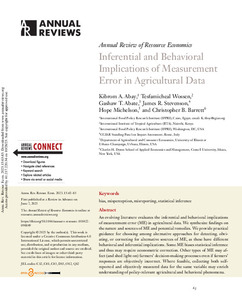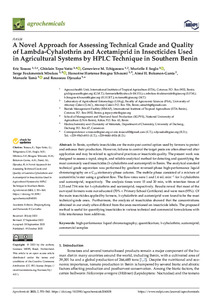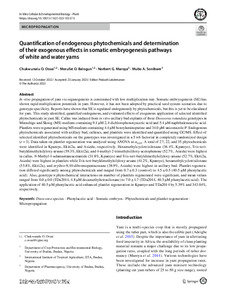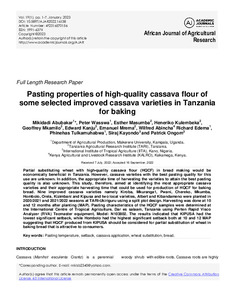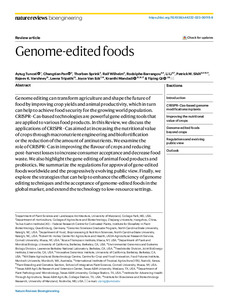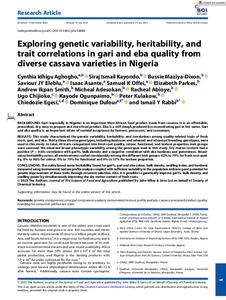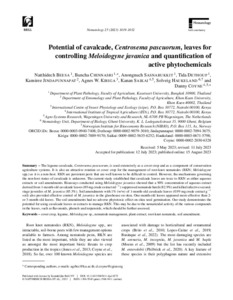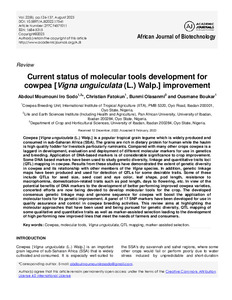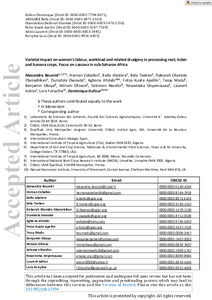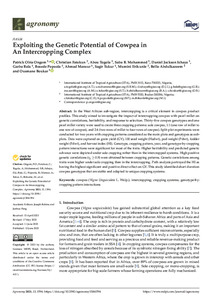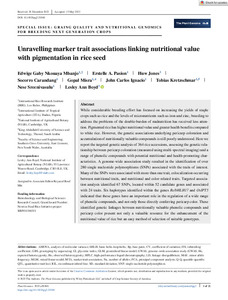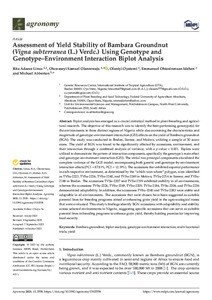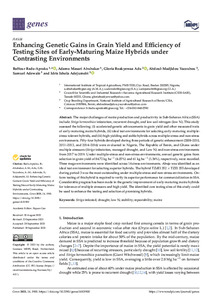Welcome to the International Institute of Tropical Agriculture Research Repository
IITA Bibliography System: Recent submissions
Now showing items 321-340 of 8094
-
Optimum maize planting window and season length for climate adaptation in Kano, Nigeria
(IInternational Institute of Tropical Agriculture, 2023) -
Evidence for metabolite composition underlying consumer preference in sub-Saharan African Musa spp.
(2024-03)Breeding programs for disease resistant bananas in Sub-Saharan Africa generated resistant bananas, which did not meet fruit quality characteristics preferred by consumers. The present study aimed to establish chemotypes underlying preferred cooking bananas of Matooke, Mchare and plantain and less preferred Mbidde bananas, used for beer brewing. The metabolite data of Mbidde showed higher levels of metabolites associated with sour, sweet, and astringent taste; as well as different textural properties ... -
Association mapping of candidate genes associated with iron and zinc content in rice (Oryza sativa L.) grains
(2023-09)Micronutrient deficiencies, particularly of iron (Fe) and zinc (Zn), in the diet contribute to health issues and hidden hunger. Enhancing the Fe and Zn content in globally staple food crops like rice is necessary to address food malnutrition. A Genome-Wide Association Study (GWAS) was conducted using 85 diverse rice accessions from the Democratic Republic of Congo (DRC) to identify genomic regions associated with grain Fe and Zn content. The Fe content ranged from 0.95 to 8.68 mg/100 g on a dry ... -
Inferential and behavioral implications of measurement error in agricultural data
(2023-10)An evolving literature evaluates the inferential and behavioral implications of measurement error (ME) in agricultural data. We synthesize findings on the nature and sources of ME and potential remedies. We provide practical guidance for choosing among alternative approaches for detecting, obviating, or correcting for alternative sources of ME, as these have different behavioral and inferential implications. Some ME biases statistical inference and thus may require econometric correction. Other ... -
A novel approach for assessing technical grade and quality of Lambda-cyhalothrin and acetamiprid in insecticides used in agricultural systems by HPLC technique in southern Benin
(2023)In Benin, synthetic insecticides are the main pest control option used by farmers to protect and enhance their production. However, failures to control the target pests are often observed after application and may be related to agricultural practices or insecticide quality. The present work was designed to assess a rapid, simple, and reliable analytical method for detecting and quantifying the most commonly used insecticides (λ-cyhalothrin and acetamiprid) in Benin. The analytical standard technical ... -
Quantification of endogenous phytochemicals and determination of their exogenous effects in somatic embryogenesis pathways of white and water yams
(2023-02)In vitro propagation of yam via organogenesis is constrained with low multiplication rate. Somatic embryogenesis (SE) has shown rapid multiplication potentials in yam. However, it has not been adopted by practical seed system scenarios due to genotype specificity. Reports have shown that SE is regulated endogenously by phytochemicals, but this is yet to be elucidated for yam. This study identified, quantified endogenous, and evaluated effects of exogenous application of selected identified ... -
Pasting properties of high-quality cassava flour of some selected improved cassava varieties in Tanzania for baking
(2023-01-31)Partial substituting wheat with high-quality cassava flour (HQCF) in bread making would be economically beneficial in Tanzania. However, cassava varieties with the best pasting quality for this use are unknown. In addition, the appropriate time of harvesting the varieties to attain the best pasting quality is also unknown. This study, therefore, aimed at identifying the most appropriate cassava varieties and their appropriate harvesting time that could be used for production of HQCF for baking ... -
Genome-edited foods
(2023-10-04)Genome editing can transform agriculture and shape the future of food by improving crop yields and animal productivity, which in turn can help to achieve food security for the growing world population. CRISPR–Cas-based technologies are powerful gene editing tools that are applied to various food products. In this Review, we discuss the applications of CRISPR–Cas aimed at increasing the nutritional value of crops through macronutrient engineering and biofortification or the reduction of the amount ... -
Exploring genetic variability, heritability, and trait correlations in gari and eba quality from diverse cassava varieties in Nigeria
(2023-07)BACKGROUND Gari (especially in Nigeria) is an important West African food product made from cassava. It is an affordable, precooked, dry, easy to prepare and store food product. Eba is a stiff dough produced by reconstituting gari in hot water. Gari and eba quality is an important driver of varietal acceptance by farmers, processors, and consumers. RESULTS This study characterized the genetic variability, heritability, and correlations among quality-related traits of fresh roots, gari, and eba. ... -
Potential of cavalcade, Centrosema pascuorum, leaves for controlling Meloidogyne javanica and quantification of active phytochemicals
(2023-08-15)The legume cavalcade, Centrosema pascuorum, is used extensively as a cover crop and as a component of conservation agriculture systems. It is also an attractive rotation or cover crop for the management of root-knot nematodes (RKN; Meloidogyne spp.) as it is a non-host. RKN are persistent pests that are well known to be difficult to control. However, the mechanisms governing the non-host status of cavalcade is unknown. The current study established that cavalcade leaves are toxic to RKN as either ... -
Current status of molecular tools development for cowpea [Vigna unguiculata (L.) Walp.] improvement
(2023-08)Cowpea [Vigna unguiculata (L.) Walp.] is a popular tropical grain legume which is widely produced and consumed in sub-Saharan Africa (SSA). The grains are rich in dietary protein for human while the haulm is high quality fodder for livestock particularly ruminants. Compared with many other crops cowpea is a laggard in development, evaluation and deployment of different molecular markers for use in genetics and breeding. Application of DNA-based markers is of considerable significance to crop ... -
Varietal impact on women's labour, workload and related drudgery in processing root, tuber and banana crops. Focus on cassava in sub-Saharan Africa
(2023-08-22)Roots, tubers and cooking bananas are bulky and highly perishable. In Africa, except for yams, their consumption is mainly after transport, peeling and cooking in the form of boiled pieces or dough, a few days after harvest. To stabilize, better preserve the products and, in the case of cassava, release toxic cyanogenic glucosides, a range of intermediate products have been developed, mainly for cassava, related to fermentation and drying after numerous processing operations. This review highlights, ... -
Exploiting the genetic potential of cowpea in an intercropping complex
(2023)In the West African sub-region, intercropping is a critical element in cowpea product profiles. This study aimed to investigate the impact of intercropping cowpea with pearl millet on genetic correlations, heritability, and response to selection. Thirty-five cowpea genotypes and one pearl millet variety were used to create three cropping patterns: sole cowpea, 1:1 (one row of millet to one row of cowpea), and 2:4 (two rows of millet to four rows of cowpea). Split-plot experiments were conducted ... -
Recent advances in cowpea IPM in West Africa
(2023)Cowpea is an important and climate-resilient grain legume for human and livestock nutrition worldwide. Its grains represent a valuable source of protein for rural families in Sub-Saharan Africa while its haulms offer nutritious fodder for livestock, especially, in the Sahel regions. Cowpea production, unfortunately, faces substantial challenges of field and storage insect pests which can cause up to 100% losses. The use of synthetic pesticides, although providing farmers with a good level of pest ... -
Exploring phenotypic variation of diverse bambara groundnut (Vigna subterranea L) origin and development of mini-core collection for future breeding
(2023-04-12)Understanding the phenotypic variation and designing a mini-core collection is an efficient method to accelerate the genetic gain of bambara groundnut. A collection of 300 bambara groundnut landraces from 25 different countries of origin sourced from gene banks were used to analyze phenotypic variability among the landraces and develop a mini-core collection for future breeding. The landraces were evaluated in alpha lattice design with two replications for 2 years (2019 and 2020). The results ... -
Unravelling marker trait associations linking nutritional value with pigmentation in rice seed
(2023)While considerable breeding effort has focused on increasing the yields of staple crops such as rice and the levels of micronutrients such as iron and zinc, breeding to address the problems of the double-burden of malnutrition has received less attention. Pigmented rice has higher nutritional value and greater health benefits compared to white rice. However, the genetic associations underlying pericarp coloration and accumulation of nutritionally valuable compounds is still poorly understood. Here ... -
The combining ability of extra-early maturing quality protein maize (Zea mays) inbred lines and the performance of their hybrids in Striga-infested and low-nitrogen environments
(2023-10-10)Maize production in sub-Saharan Africa (SSA) faces challenges due to the damage caused by the parasitic weed, Striga hermonthica (Del.) Benths and low soil nitrogen. To address these constraints and improve food security and nutrition, this study assessed the combining ability of 47 inbred lines and four testers, grouped them into heterotic groups, identified effective testers, and determined the stability of the lines in hybrid combinations under contrasting research conditions. The study was ... -
Assessment of yield stability of bambara groundnut (Vigna subterranea (L.) Verdc.) using genotype and genotype-environment interaction biplot analysis
(2023-10-04)Biplot analysis has emerged as a crucial statistical method in plant breeding and agricultural research. The objective of this research was to identify the best-performing genotype(s) for the environments in three distinct regions of Nigeria while also examining the characteristics and magnitude of genotype–environment interaction (GEI) effects on the yield of Bambara groundnut (BGN). The study was conducted in Ibadan, Ikenne, and Mokwa, utilizing a sample of 30 accessions. The yield of BGN was ... -
Enhancing genetic gains in grain yield and efficiency of testing sites of early-maturing maize hybrids under contrasting environments
(2023-09-30)The major challenges of maize production and productivity in Sub-Saharan Africa (SSA) include Striga hermonthica infestation, recurrent drought, and low soil nitrogen (low N). This study assessed the following: (i) accelerated genetic advancements in grain yield and other measured traits of early-maturing maize hybrids, (ii) ideal test environments for selecting early-maturing multiple-stress tolerant hybrids, and (iii) high-yielding and stable hybrids across multiple-stress and non-stress ... -
Genetic structure analysis and identifying key founder inbred lines in diverse elite sub‑tropical maize inbred lines
(2023-07-20)Understanding the genetic relationships between the key founder inbred lines and derived inbred lines could provide insight into the breeding history and the structure of genetic diversity of the available elite inbred lines with desirable target traits. The maize improvement program at the International Institute of Tropical Agriculture (IITA) analyzed the pedigree information of 623 sub-tropical maize inbred lines generated at the IITA maize breeding program to identify the key founder inbred ...




